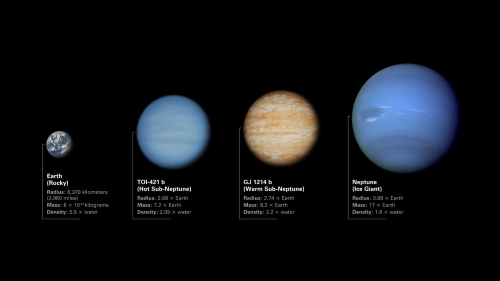Astronomers using NASA’s state-of-the-art James Webb Space Telescope have made a groundbreaking discovery of GJ 1214 b, a planet unlike any we've seen before.
Located 48 light-years away in the Ophiuchus constellation, this "super-Venus" exoplanet is shattering existing ideas about planetary classification and formation.
With a dense atmosphere primarily composed of carbon dioxide, GJ 1214 b offers fascinating new insights into the evolution of planets.

Source : webbtelescope
What Makes GJ 1214 b Unique?
GJ 1214 b occupies a distinct position in planetary classification, sitting between Earth-like rocky worlds and Neptune-like ice giants.
Unlike planets dominated by hydrogen or water, this exoplanet challenges previous models with its carbon dioxide-rich atmosphere.
Here are the key features of GJ 1214 b:
| Feature | Details |
| Planet Name | GJ 1214 b |
| Distance from Earth | 48 light-years |
| Location | Ophiuchus Constellation |
| Atmospheric Composition | Mainly Carbon Dioxide |
| Planet Type | Super-Venus (Intermediate between Earth & Neptune) |
| Discovery Tool | James Webb Space Telescope |
What are the Groundbreaking Observations from the James Webb Telescope?
The James Webb Space Telescope (JWST) used its advanced spectroscopy to analyze the planet’s atmosphere by observing the starlight that passes through its clouds. This breakthrough technology has enabled astronomers to identify the chemical makeup of GJ 1214 b with unparalleled accuracy.
| Note: What is James Webb Space Telescope?
Sourc: NASA The James Webb Space Telescope launched on December 25, 2021, is a cosmic game-changer! With gold mirrors, infrared vision, and a sunshield the size of a tennis court, JWST reveals galaxies, stars, and planets like never before. Peering into the early universe, it’s redefining our place in the cosmos. |
What Was Discovered?
- Atmosphere Composition: GJ 1214 b's atmosphere consists mainly of carbon dioxide (CO2) — a stark contrast to the hydrogen-heavy planets usually found in this size range.
- No Water: Unlike previously speculated, this exoplanet doesn’t exhibit water-dominated features, further adding to the mystery.
Why is GJ 1214 b Important?
- Expands our knowledge of planetary systems far beyond our own.
- Challenges existing theories about exoplanet formation and evolution.
- Offers a unique perspective on how atmospheres develop on mid-sized planets.
Why is GJ 1214 b a Game-Changer?
- GJ 1214 b’s discovery challenges the traditional thinking around planetary formation and evolution.
- Typically, planets of this size are expected to have a hydrogen-rich atmosphere or be dominated by water.
- However, the dense carbon dioxide atmosphere of GJ 1214 b suggests an unusual formation process and intense geological activity. This could offer insights into how planets transition from rocky worlds to gas giants.
What are the Theories and Implications for Planetary Science?
- Astronomers speculate that GJ 1214 b's extreme atmosphere could result from intense volcanic or geological activity, similar to Venus but on a larger scale.
- These findings could potentially bridge the gap between terrestrial planets (like Earth) and gas giants (like Neptune), reshaping how we understand planetary evolution.
What’s Next to Do with Planetary Exploration?
- The discovery of GJ 1214 b highlights the tremendous potential of the James Webb Space Telescope in unraveling the mysteries of distant exoplanets.
- Researchers are now focused on studying more exoplanets to understand the variety of atmospheres, planetary conditions, and evolutionary paths.
What are the Future Goals?
- Expand the study of similar exoplanets with unusual atmospheric compositions.
- Refine models of planetary evolution based on these new findings.
- Explore the possibility of habitability on planets with unusual atmospheric conditions.
Conclusion: A New Era in Exoplanet Exploration
The discovery of GJ 1214 b, a “super-Venus” exoplanet, marks a significant milestone in the study of distant worlds. Its carbon dioxide-heavy atmosphere and unique formation theories challenge our current understanding of planetary science and open doors to future discoveries.
As NASA’s James Webb Space Telescope continues to explore the cosmos, further revelations about the diversity of exoplanets will undoubtedly enhance our comprehension of the universe.
Read| Who is Janet Petro? Meet the First Woman to Lead NASA as Acting Administrator
Read| Interstellar Object May Have Reshaped Our Solar System's Planetary Orbits
Read| How Light Pollution Is Threatening the Very Large Telescopes in Chile: An Expert’s Warning

Comments
All Comments (0)
Join the conversation